Whenever you go grocery shopping at a market or supermarket, heading to the fruit section to pick out some fruits for your family, you’ll notice a variety of fruits on display. But some fruits catch your eye—they look strange yet fascinating, almost like they came from another planet.
You’re right to think that! These aren’t your everyday fruits; they’re exotic fruits. These special gems come from different regions around the world and are rare, unlike common fruits like apples or bananas that are widely available. Did you know that these fruits not only have unique shapes but also offer incredible flavors and excellent health benefits?
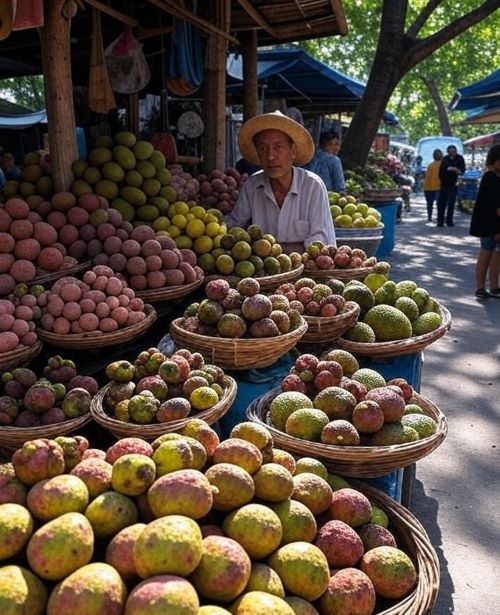
The introduction we have shared is to highlight the unique qualities and rarity of exotic fruits, showing you why they’re so special. In this article, we’ll guide you on how to identify exotic fruits in a fun and exciting way. When you confidently recognize and buy exotic fruits yourself, then taste them and enjoy a deliciously sweet fruit, you’ll know your skills in spotting these treasures have truly leveled up!
You must be eager to get started, so let’s dive in and learn how to identify exotic fruits!
What are exotic fruits, and why is it essential to identify them?
Did you know that exotic fruits are not only beautiful and colorful but also incredibly delicious and nutritious? As you may know, these exotic fruits travel from various countries where they are grown, and they are considered quite rare. The regions where these fruits are cultivated include Southeast Asia, South America, and Africa.
Therefore, these fruits are a precious gift of nature, as they are not only visually appealing but also highly beneficial for human health, being rich in vitamins and antioxidants. Some well-known types of exotic fruits include dragon fruit, kiwano, mangosteen, and passion fruit, among others.
Let’s talk about why you need to know how to identify exotic fruits. When you invest your time and money, you aim to buy things for your loved ones that are healthy, delicious, and free from harmful effects.
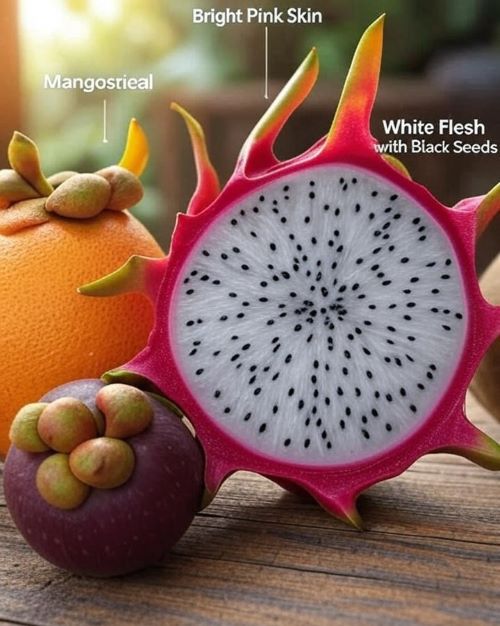
Therefore, when you know how to identify fruits, you will always choose those that are fully ripe and flavorful, avoiding fruits that are unripe, sour, or tasteless. This is why it’s important to understand that the exotic fruits you bring home are not only tasty but also packed with nutrients like vitamin C. For example, dragon fruit is rich in fiber, which strengthens the digestive system, while kiwano fruit fulfills your body’s vitamin C needs.
As we all know, the world has become a global village, and thanks to modern technology and advanced shipping methods, exotic fruits can now be easily and efficiently delivered fresh to fruit markets and online fruit shopping stores across various countries.
These fruits are readily available in stores in fresh condition. However, since these fruits are often shipped in large quantities, unripe and ripe fruits can get mixed. This is where your skill in identifying high-quality, fresh exotic fruits, as outlined in this guide, will prove invaluable.
By learning to select the best exotic fruits, you ensure that you bring home ripe, flavorful, and nutrient-rich produce, optimizing both taste and health benefits for you and your family.
Step-by-Step Guide: How to Identify Exotic Fruits Like an Expert:
Identifying exotic fruits isn’t rocket science; with some basic knowledge about fruits and a bit of astute observation, you can become an expert yourself. For your convenience, we’ll guide you step-by-step on how to master the art of selecting exotic fruits.
Step 1: Recognize Their Appearance:
As we all know, the first thing that catches our eye when we look at something is its appearance. Therefore, the first clue in identifying exotic fruits is their visual characteristics. Exotic fruits often have a unique, distinctive look, such as a wild appearance, vibrant colors, or unusual and peculiar shapes that set them apart from common fruits.
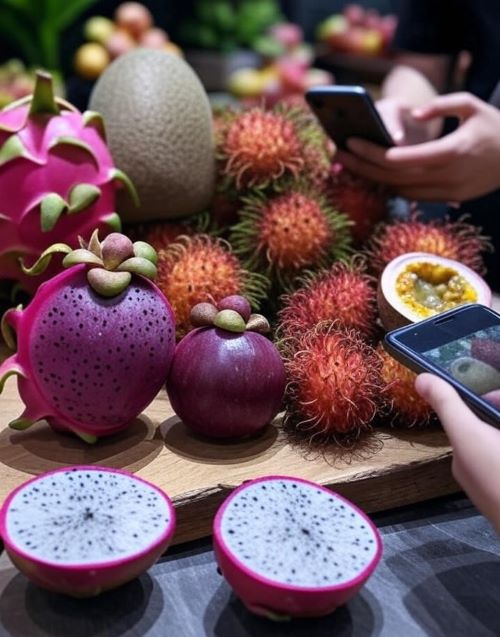
- Check the color: Bright hues are a big hint. For instance, a ripe dragon fruit has vibrant pink or yellow skin with green scales. If it’s dull or green, it’s not ready yet.
- Examine the shape and size: Some are round like mangosteen, which looks like a purple baseball with a stem cap. Others are oval or spiky, like the horn-shaped kiwano.
- Spot unique features: Look for hairs on rambutan, thorns on durian, or wrinkles on passion fruit.
When you’re in a store, please take a moment to compare it to pictures on your phone or store labels. This visual check is key to selecting exotic fruits that are fresh and ripe.
2: Feel the Texture:
Touch is your next tool for exotic fruit identification. Gently handle the fruit to avoid bruising it.
- Test for firmness: A ripe mangosteen should feel slightly soft, like a tomato, but not mushy. If it’s rock-hard, it’s unripe.
- Feel the skin: Rambutan has soft, flexible spines, while durian is thorny and challenging.
- Weigh it in your hand: Heavier fruits like jackfruit often mean more juicy flesh inside.
Feeling the texture helps you choose exotic fruits that are at peak ripeness, ensuring a tasty experience when you get exotic fruits home.
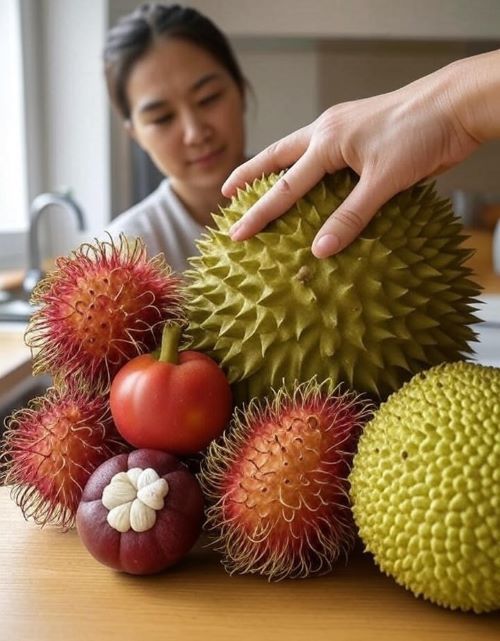
3: Smell for Freshness:
Your nose knows! Many exotic fruits have strong scents that give away their identity and readiness.
- Sniff gently: A ripe passion fruit smells sweet and floral, like perfume. Durian is famous (or infamous, depending on a person’s sense of smell) because the passion fruit has a strong odor reminiscent of onions and custard.
- Avoid nasty smells: If it smells sour or fermented, it might be overripe.
I recall a funny incident at a fruit stand in Brazil where a vendor handed me a cupuacu fruit. Its chocolatey, pineapple-like aroma drew me in immediately. That scent convinced me to buy it on the spot, and it became one of my favorites. Use your sense of smell to pick exotic fruits that promise great flavor.

4: Listen and Tap (If It Makes Sense):
This step is trickier but fun for some fruits.
- Tap lightly: For jackfruit, a hollow sound means it’s ripe.
- Shake gently: Passion fruit might rattle if the seeds are loose inside.
Not all fruits need this, but it’s a nifty trick for bigger ones.
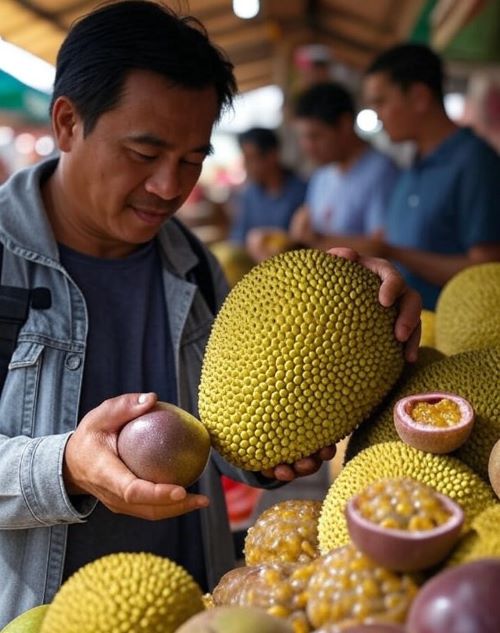
5: Taste Safely (After Buying):
Once you’ve purchased exotic fruits, cut them open and taste.
- Start small: Nibble a bit to confirm—dragon fruit tastes mildly sweet with crunchy seeds.
- Pair with familiar foods: Mix kiwano jelly-like insides with yogurt.
Tasting seals the identification and encourages more exotic fruit purchases.

6: Read Labels and Ask Questions:
Don’t forget human help!
- Check origins: Labels might say “From Thailand” for rambutan.
- Ask store staff: They can point out tropical fruits and share tips.
This step builds confidence to acquire exotic fruits regularly.
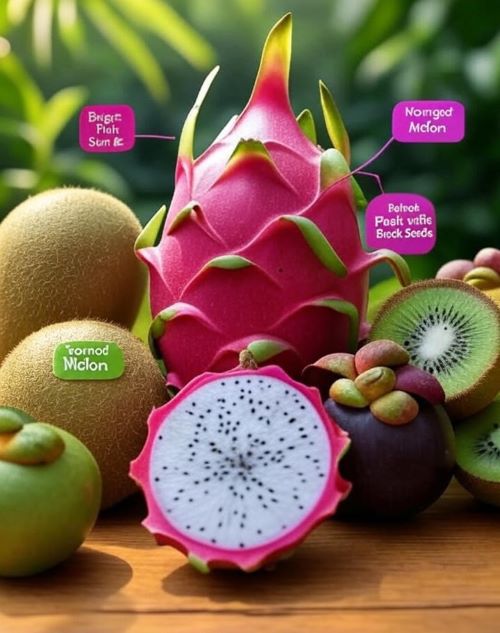
Popular Exotic Fruits and How to Spot Them:
Let’s zoom in on specific exotic fruits to make identification easier. Each has unique traits.
Dragon Fruit: The Pink Wonder:
This cactus fruit from Asia and Mexico looks like a flame with pink skin and green tips. Inside, it’s white or red with black seeds. Identified by its scaly exterior—ripe ones are bright and yield to gentle pressure. Buy dragon fruit for its refreshing taste in smoothies. It’s low-calorie and hydrating!
Kiwano: The Horned Melon:
From Africa, this orange, spiky fruit resembles a cucumber with horns. Cut it open for green, seedy jelly. Spot exotic fruits like this by the spikes—they’re soft, not sharp. Smells cucumbery. Purchase kiwano to add zest to salads; it’s vitamin-rich.
Rambutan: The Hairy Delight:
Native to Southeast Asia, it’s red and hairy like a lychee cousin. Peel to find translucent flesh. Exotic fruit identification tip: Flexible hairs mean ripe. Sweet and juicy—get rambutan for snacks.
Mangosteen: Queen of Fruits:
Purple rind with white segments inside, from Indonesia. Identified by the thick cap and slight give. Tastes like peach and pineapple. Buy mangosteen for its antioxidants.
Durian: King of Fruits:
Spiky, smelly giant from Asia. Creamy pods taste like almond custard—spot by thorns and odor. Acquire durian despite the smell—it’s nutritious!
Passion Fruit: The Wrinkly Gem:
From South America, purple or yellow, wrinkled when ripe. Gooey seeds inside. Identify exotic fruits by wrinkles and aroma. Tangy—perfect for juices. Purchase passion fruit for vitamin A.
Jackfruit: The Giant:
The largest fruit is green and bumpy. Stringy flesh like pulled pork. Exotic fruit spotting: Size and bumps. Versatile for vegan meals—buy jackfruit now!
More rarities: Star fruit (star-shaped slices), lychee (rough red skin), pitaya (similar to dragon fruit).
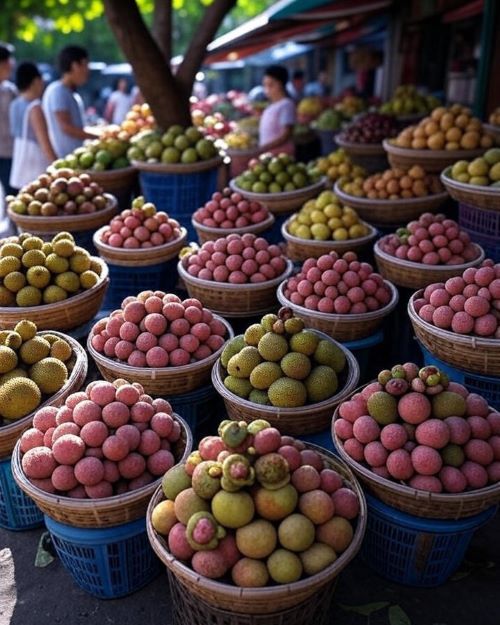
Time to Discover Exotic Fruits!
You have now got the tools to identify exotic fruits effortlessly. From visual checks to sensory tests, you are set for adventure. Don’t wait—head to your store or buy exotic fruits online today. With confidence from this guide, every bite will be a win. Share your stories; who knows what delicious finds await?

